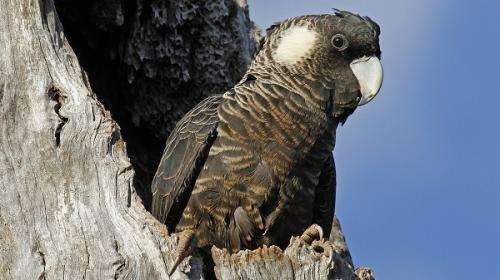Carnabys favour roomier artificial homes

Scientists are investigating which type of tree hollows are best suited to endangered Carnaby's Cockatoos for breeding purposes, as part of a larger study into threats to the birds survival.
The research involving CSIRO, Perth Zoo and the Department of Parks and Wildlife at Coomallo Creek in the Wheatbelt examined various threats to the birds between 1969 and 2013.
Perth Zoo expert Dr Peter Mawson says there has been no scientific basis for recommending one type or sized artificial hollow over another.
He says this research will assist developers, landowners and conservation agencies to install suitable artificial hollows to replace those lost for development.
"As part of some development approvals for mines and infrastructure developments such as roads and railways, natural hollow-bearing trees have to be removed," Dr Mawson says.
"Under both federal and state legislation, it is possible for the regulating authority to require that artificial hollows be put up to off-set those lost."
The Carnaby's Cockatoo uses the large hollows in old eucalyptus trees for breeding.
Their numbers have been declining due to the impact of native vegetation clearing for intensive agriculture and other types of land development.
Without intervention, their numbers will continue to dwindle as they find many natural hollows unsuitable for breeding as they are too small, occupied by other species of bird or feral bees, damaged, too shallow or too deep.
Wildfire impacts on nesting sites
In December 2010, a wildfire destroyed 16 nest trees in the study site. To address this loss, researchers put up 30 artificial hollows; some 270mm in diameter others 300mm in diameter.
"We monitored the cockatoos' response and learnt that they didn't like the smaller diameter hollows and had more success in the larger ones," Dr Mawson says.
"This year we replaced all the 270mm diameter artificial hollows with 400mm diameter hollows and expect most of them will be used."
The research has revealed how rapidly hollows are being lost from service or the trees that bear them are falling over.
"The rate of loss is far exceeding the rate that trees are reaching an age and size that new hollows are forming naturally," Dr Mawson says.
"Artificial hollows are the only means of addressing this deficiency until a lot more new trees can be planted and have time to grow large enough to produce hollows," he says.
More information: Denis A. Saunders, Peter R. Mawson, Rick Dawson, "Use of tree hollows by Carnaby's Cockatoo and the fate of large hollow-bearing trees at Coomallo Creek, Western Australia 1969–2013," Biological Conservation, Volume 177, September 2014, Pages 185-193, ISSN 0006-3207, dx.doi.org/10.1016/j.biocon.2014.07.002.
Journal information: Biological Conservation
Provided by Science Network WA





















